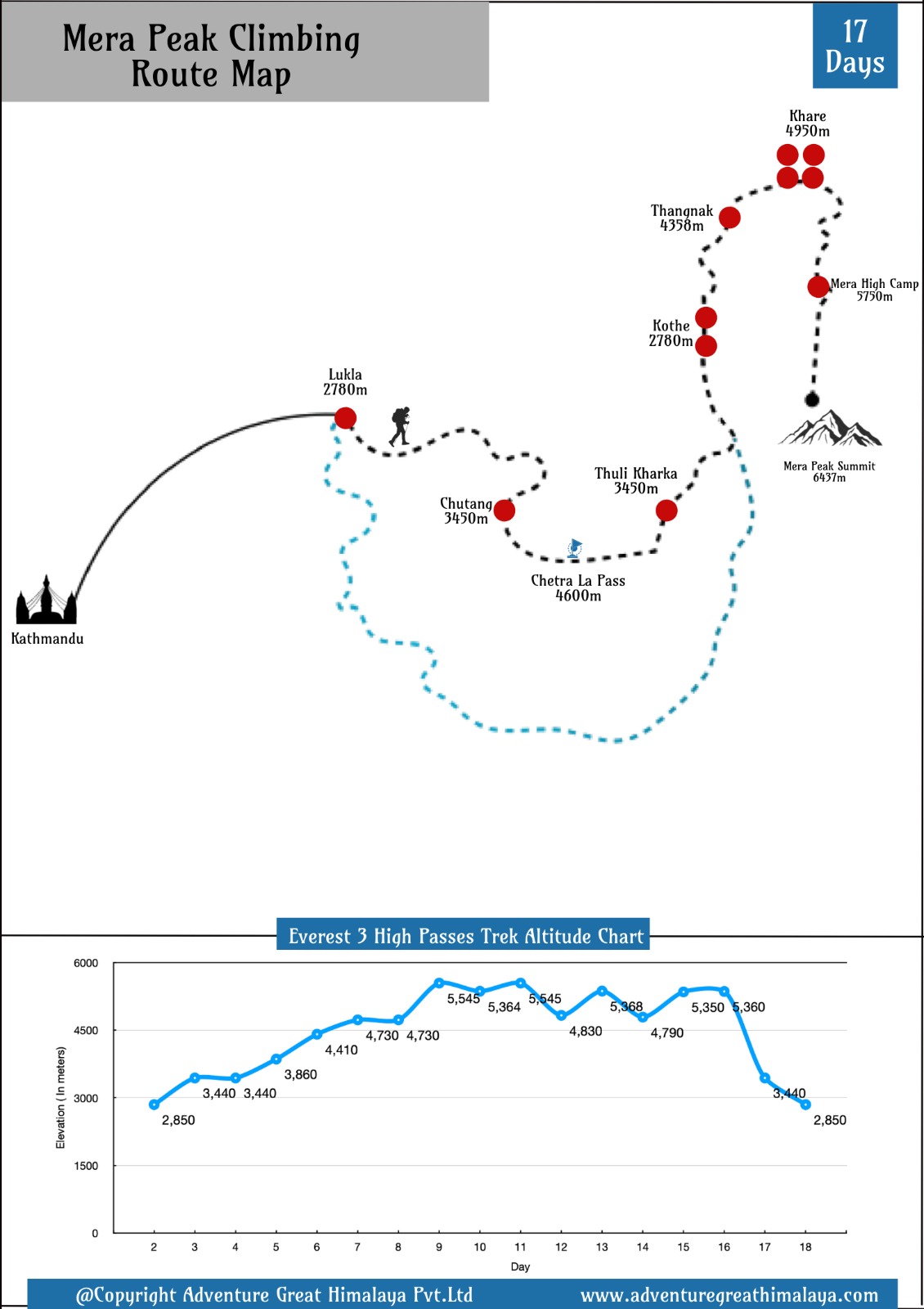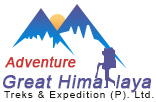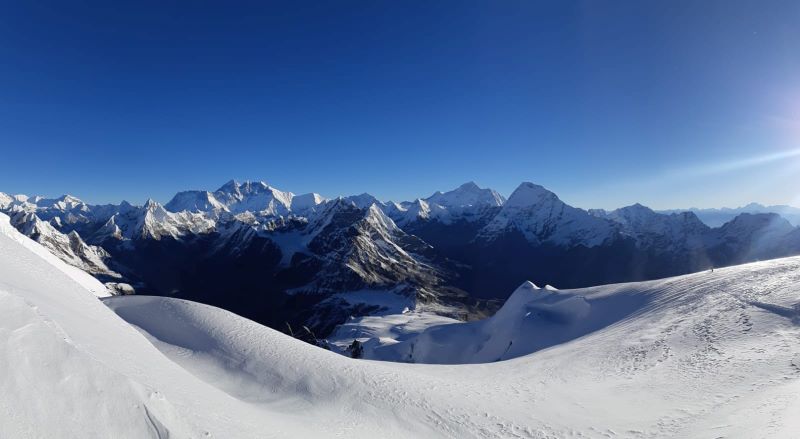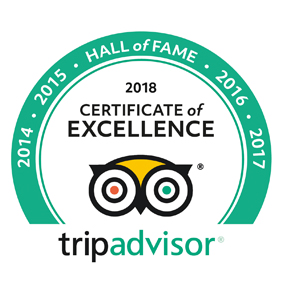Overview
If you have previous high altitude trekking experiences, Climb Mera peak is a perfect adventure waiting for you. If you plan on climbing the Mera Peak, you will be rewarded with a panoramic view of the mountain ranges such as Mount Everest, Mount Lhotse, Mount Cho Oyu, Mount Kanchanjungha and Mount Makalu.
Mera Peak Climbing offers an incredible trekking experience into the gorgeous Mera peak. The extreme altitude during Mera peak climbing is a tough challenge. Even if you’re fit, this challenging trek demands lots of stamina, endurance, and few technical skills.
Climb to Mera Peak begins with a flight from Kathmandu to Lukla. From Lukla, you will trek to Chutang, Chetra la pass 4600m, Thulikharaka, Kothey, Tangnag, Khare, and to Mera High camp. You’ll be camping at the Mera high camp for a night. From high camp, you will summit the Mera 6476 meters peak to catch a mesmerizing sunrise view.
During Mera Peak Expedition, trekkers can experience trekking and climbing, both at the same time. You must use various climbing equipment for Mera peak climbing. If you’re a beginner, climbing the Mera peak can be difficult. We advise you to get some training on using the climbing equipment. Also, you should do some training to build up a strong physique.
You will be able to witness various waterfalls, lakes, and passes along the way to Mera Peak. The lush jungles filled with varieties of wild flora and fauna will allure you. The journey to Mera peak is beautiful.
Mera Peak Climbing with Adventure Great Himalayas will be more interesting and fun. We have well-experienced representatives to help you throughout your journey. You will have proper food and accommodation facilities as well.
You’ll have one of the best climbing expeditions if you plan Mera Peak with us.
Highlight of Mera Peak Expedition
- Climbing the Mera Peak, the highest trekking peak in Nepal.
- Exploring the beautiful view of the mountains such as Mount Everest, Makalu, Kanchanjungha, Amadablam, Thamserku, and many others.
- Exploring the Sherpa Villages, the people, and their lifestyle.
- An opportunity to explore the beautiful Everest region.
Best Time to Climb Mera Peak
Autumn and Spring are one of the best seasons for trekking and climbing the Mera Peak. The autumn season lasts in the month of September, October, and November. During autumn the weather and temperature of the Everest region are around 12 degrees during the daytime. The temperature at the peak may fall to minus. Although the weather may be cold at the peak, it is bearable. You can also have amazing visibility of the mountains and landscapes during the autumn season.
Similarly, Spring falls in the month of March, April, and May which is favorable for Mera Peak expedition. The average temperature of the Everest region is around 10 degrees during the daytime. The temperature may fall to minus during the night time. You will be able to witness the scenery of the mountains and landscapes even more vividly during the spring season.
The temperature of the Mera is cold in every season but, the temperature reaches its minimum during the winter season. If you wish to climb the peak during winter, make sure you carry proper trekking and climbing equipment.
Mera Peak Climbing Difficulty
Mera Peak stands at an altitude of 6476 meters making it the highest trekking peak in Nepal. The difficulty level depends upon various factors such as the time of the year you will be trekking. It also depends on your strength. If you are someone who is used to trekking and mountain climbing above 4000 meters to 5000 meters, Mera Climbing might be a next to perfect adventure for you. But if not, it may be quite challenging as it requires a lot of stamina and endurance.
Trekking to the Mera Peak means you may have to walk for 4 days above the altitude of 5000 meters. So, there is a high chance of altitude sickness. You may be in short of breath as you trek to the Mera peak as at this altitude, the content of oxygen in the air is half of what it is at the sea level. If you find susceptible to altitude sickness with symptoms such as headache, nausea, and vomiting, immediately descend to a lower altitude. For climbing Mera Peak, you should be able to walk for about 6-7 hours.
Mera peak Climb Itinerary
Cost Include/Exclude
What’s include
- Airport / Hotel Airport Transfer
- Three night’s 3 Star Hotel in Katmandu.
- 3 meals a day During the trek (Breakfast, Lunch and Dinner)
- All Trekking and Climbing Permit
- Domestic Flight Ticket ( Kathmandu- Lukla- Kathmandu )
- All accommodations in lodges/tea houses during the treks.
- Trekking and Climbing Guide
- Trekking porter ( One porter for 2 members)
- General climbing equipments
- Garbage fee.
- Arrangement of Emergency Helicopter service which will be paid by your Travel insurance company.
- Medical supplies (first aid kit will be available).
- All government taxes.
- Service charge.
What’s excluded
- International airfare and Nepal entry visa fee
- Personal travel insurance and also rescue evacuation in case of emergency
- All Lunch/Dinner in Kathmandu.
- Personal Climbing Equipment.( you may rent it cost about 50-100 USD per head
- All Bar bills and personal expenses( phone call, laundry service, battery recharge, bottle of water, hot water, shower, pot of tea, coffee etc.
- Tips
Climbing Equipments
Climbing Equipment
- Climbing Harness
- Crampons
- Ice Ax
- Ascender
- Headlamp
- Locking and non-locking Carabiners
- Rappel/ Belay device
- Ski poles
- Ropes
- Slings
- Prusik Cords
Upper Body Wear
- Lightweight Merino long-sleeve t-shirt
- Fleece jacket
- Medium-weight fleece pullover
- Lightweight down jacket
- Breathable and Waterproof jacket
- Lightweight thermal base layers
Lower Body Wear
- Walking shorts/trousers
- Lightweight underwear briefs
- Lightweight thermal bottoms
- Fleece trouser
- Heavy thermal bottoms
- Waterproof and breathable trousers
Handwear
- Lightweight poly-liner gloves
- Medium weight gloves
Headwear
- Synthetic or warm wool hat
- Head Scarf or Bandana
- Scarf, buff, or neck sleeve
- Sun hat
- Ski goggles
- Face mask
- Glacier sunglass
Footwear
- Medium or heavy wool or poly socks
- Lightweight wool or cotton socks
- Cross trainers or running shoes
- Sturdy synthetic or leather hiking boots
Travel Bags
- Large waterproof duffle kit bag (120 L)
- Medium rucksack (50- 70 liter)
- Pack cover
- Small and protective padlocks
- Sleeping Gear
- Down sleeping bag (rated -35 C/ -30 C)
- Closed-cell foam mat
More Trip Info
Mera Peak Expedition – Safety Method
Safety is at the foundation of a successful Mera Peak expedition. Your alpine journey will expose you to risks such as high altitude, adverse weather and challenging terrain. Despite this, we ensure the safety of all members with meticulous planning, expert leadership and constant risk management.
Each stage of the journey from pre trip planning to the summit day follows safety steps that help prevent accidents and be very well prepared to manage any unforeseen situations. We help you feel confident and well-prepared by combining expert guidance, a slow and safe acclimatization process, strong communication systems and close attention to your health and well-being throughout the Mera Peak expedition.
All our expeditions are accompanied by government-certified, high-altitude experienced guides and strong local porters, the itinerary includes a number of rest days and gradual successive gains in altitude to facilitate easy acclimatization to high altitude.Oxygen levels each day, pulse and body symptoms are checked for early signs of altitude sickness.
There are satellite phones, medical kits, oxygen cylinders and helicopter evacuation arrangement facilities in case of a medical emergency.The technical and safety equipment like ropes, helmets, crampons and harnesses, is used for the expedition that meets international safety standards.
The pre climb training and preparation at base camp familiarizes you with equipment and glacial travel. Regular weather updates help guide decision-making and may delay climbs when necessary for safety. The path is evaluated for crevasses, avalanche risk and other dangers prior to ascending to the summit.
Altitude Sickness and Treatment
Altitude sickness or Acute Mountain Sickness (AMS) is a condition commonly experienced by adventure enthusiasts at high elevations. With every climb of Mera Peak, you will reach the alpine zones which means low air pressure and less oxygen. This will become increasingly challenging for your body to function normally. Symptoms of AMS include mild headache, nausea and dizziness, to more severe shortness of breath, confusion and rapid heartbeat. The signs usually start to appear when you go above 2,500 meters, especially if you ascend too quickly.
Acclimatization is the best way of preventing altitude sickness. On the way to Mera Peak, the itinerary is planned with gradual ascents in elevation so that you are acclimatized to the thinner air at a slow and safe pace. There are rest days so that the body can acclimatize. In addition to following the planned schedule you must also drink lots of water to remain well hydrated and not overexert yourself since physical exertion can exacerbate the risk of altitude sickness.
If you experience symptoms of altitude sickness, prompt action is necessary. The first course of action is to stop climbing and stay at the same altitude. If the symptoms worsen and become severe, the best treatment is to descend to a lower level. Supplemental oxygen and medication like Diamox also relieve symptoms and speed up the recovery process. Our guides also know how to recognize the symptoms of AMS and are authorized to take instant action including oxygen administration or an emergency descent if required.
Required Travel Insurance
Travel insurance is an essential requirement for undertaking the climb of Mera Peak. Given the high altitude nature of the climb and the remoteness of the region, it is required to have insurance that covers alpine mountaineering and emergency evacuation.
In case of altitude sickness, injury or sudden accidents, helicopter rescue and evacuation may need to be done and without proper insurance coverage, this will be extremely expensive. Thus, you need to make sure that your insurance policy covers emergency airlift and hospitalization.
Moreover, the travel insurance has also got to cover other possible travel related problems including trip cancellations, delays and lost or theft luggage. Inclement weather, health issues or other unexpected circumstances may occasionally disrupt your travel plans and having an insurance policy offers peace of mind.
Before you leave on the expedition, double-check with your provider to ensure that your policy insures everything that you require for trekking in high altitude and climbing mountains in Nepal. And carry a copy of your insurance details and emergency contact information with you on the journey.
Mera Expedition Meals and Accommodation
During the Mera Peak expedition, hot and freshly cooked meals are provided to you with the objective of keeping your body healthy and charged throughout. The food at the tea houses along the way is a mix of local and international such as pasta, thukpa, vegetables, momo, chowmein, flatbreads, eggs and meat.
Dal Bhat, the Nepali staple of rice, lentils and curries, is one of the standard, filling fare. As you ascend higher, especially at Mera High Camp, the meals are prepared by the expedition cook team in the tent camps. They are simple but warm, healthy, carbohydrate and hydration based fare to facilitate altitude acclimatization.
On the trekking sections, you will overnight in basic tea houses. These are the local mountain lodges with the simplest dormitory rooms, shared toilet and communal dining area. The tea houses maintain a traditional atmosphere and offer a clean, comfortable place to stay, with homely surroundings and heart-warming hospitality.
As the trek progresses to the higher altitudes, specifically beyond Khare, the lodgings are shifted to tent camps. The tents will usually be shared with other climbers. Warm sleeping bags with insulated mattresses are provided to keep you warm. The camp setup includes a dining tent, a toilet tent and a kitchen tent under the supervision of the support staff for safety as well as sanitation even at the remote site.
Mera Peak Climbing Permit
Mera Peak is a trekking peak declared by the Nepal Mountaineering Association (NMA). The most important permit is the Mera Peak Climbing Permit which is obligatory for all climbers and varies in cost depending on the time of year. The cost of this permit is more expensive in peak climbing seasons of spring ($ 4,000) and autumn ($ 2,000) and cheaper during low periods like winter and summer ($ 1,000 each season). The permit grants access to the mountain for climbing and funds local conservation and rescue efforts.
In addition to the climbing permit you will need the Makalu Barun National Park Entry Permit ($ 22) as Mera Peak is located within the park. You will also need a Local Area Permit (Khumbu Pasang Lhamu Rural Municipality Permit) that costs NPR 2,000 ($15) for the first four weeks and NPR 2,500 ($18) after that. It is an important permit to access the restricted area for trekking and mountaineering activities.
We will arrange all three permits prior to you going for the Mera Peak Climbing trip since they are needed in order to proceed through checkpoints along the way.
Mera Peak Expedition Cost
Price of the Mera Peak trek may vary based on services included, group size and season. Our full service option is available for just $2,100 per person. It provides the best value to climbers who desire a professionally organized and hassle free mountain climbing experience.
All the major expenses like local flights (Lukla–Kathmandu–Lukla), permits, tea house and tent stays, trek and climb meals, cost of climbing guide, porters, group equipment and airport pickups are covered in this cost. You will not be surprised by any hidden charges or unexpected expenses rather you can focus completely on enjoying your journey.
Our package is designed to provide you with a safe and enjoyable trekking and mountaineering adventure under the guidance of experienced guides and full logistical services along with acclimatization days as required. With us, you will enjoy a complete climbing package that ensures safety, comfort and the best chance of success on one of Nepal’s most popular and tallest trekking peaks.
Cheap to expensive alternatives for the Mera Peak climbing expedition will be available so you can choose as per your desire. Simply share your plans with us and we are flexible and happy to make adjustments according to your needs and interest levels.
Is this Trip For Me?
The Mera Peak expedition is ideal for adventure seekers who would like to see the outstanding high altitude views of the Nepal Himalayas. The climb is technically easy but it still requires a very high level of fitness and some experience in trekking because of the high altitude and challenging terrain involved.
You also need to be in good health, have no serious medical conditions and be willing to withstand the challenges of alpine trekking and climbing. Strong endurance, mental concentration and the ability to walk several hours a day on uneven ground with changing weather are still necessary. Pre-acclimatization experience at high altitude is highly recommended because it will condition your body and mind to the strain of the climb.
This expedition is suitable for all those who have trekked at 4,000 meters or higher and want to take their climbing experience to the next level. If you are someone who seeks adventure and enjoy pushing your boundaries, Mera Peak is an appropriate opportunity to summit a 6,476-meter peak and admire panoramic vistas of among the world’s highest mountains such as Everest, Makalu and Kanchenjunga.
We recommend the Mera Peak ascent for individuals who are prepared and want a challenging but achievable experience. Regardless of your experience our team will take you through each step of the way, building a secure and memorable experience that best fits your needs and desires.
Trip Map








